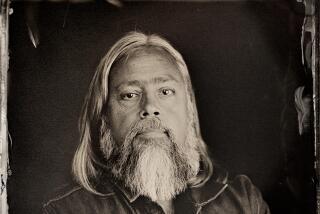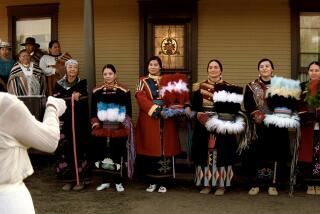Two Faces of History
- Share via
It happened 120 years ago, and yet the Battle of the Little Bighorn remains in our collective memory. It is all tangled up with how we see ourselves, how we view westward expansion and who we root for in our heart of hearts--Custer and his 210 doomed men or the Sioux, Cheyenne and Arapaho warriors who won the battle so dramatically but lost the long, genocidal war.
“Inventing Custer: Legends of the Little Bighorn” opens Saturday at the Autry Museum of Western Heritage in Griffith Park. The show, which continues through Sept. 2, is precisely the sort of thing the Autry does best: a thoughtful, multifaceted examination of a story that is both history and myth.
Instead of trying to force the visitor’s response, the exhibit allows us to draw our own conclusions from objects and artifacts that include everything from Native American weapons to Custer’s socks.
“Our goal,” says Autry curator James Nottage, “is not to draw conclusions about whether Custer was a hero or a villain, but to give visitors multiple points of view and an opportunity to reflect upon the process and the reasons why this particular soldier and this particular battle have come to have such lasting and controversial, yet fundamental meaning.”
The Autry material is rich indeed. Here is Custer’s 1861 commission as a second lieutenant on his graduation from West Point, signed by Commander in Chief Abraham Lincoln. Custer barely hung onto last place in his class of 34. As one of his classmates recalled, “He had more fun, gave his friends more anxiety, walked more tours of extra guard and came nearer to being dismissed more often than any cadet I have ever known.”
That he was a sorry excuse for a cadet didn’t harm him a whit. Custer had the great good fortune to segue directly from West Point to the killing fields of the Civil War, where he took to battle like a cat to cream. “Glorious War!” Custer called it.
In this year’s “Fields of Battle,” military historian John Keegan writes about Custer and the battle that both ended his life and gave him immortality. “George Custer was not a nice man,” Keegan observes. “Brave, certainly, bold, dashing, quick in decision, physically attractive, both to men and women, sexually alluring, all that; but nice, no.”
*
Nice, schmice. Custer was cited for bravery at the Battle of Bull Run, and, by the time he was 34, thanks to shameless self-promotion, he was already a national celebrity, sufficiently well-known as the Boy General to publish a popular autobiography. Custer was a member of that charismatic minority that everyone wants to know more about. As such, his niceness was as irrelevant as Madonna’s.
The Sioux and their allies called Custer “Yellow Hair” or “Long Hair” because of the romantic way he let his strawberry blond curls brush his shoulders (although his hair was short at the time of his final battle). Always a fancy dresser, he affected buckskin chic after he was posted with the Seventh Cavalry to the frontier (you can see one of his buckskin suits in the exhibit).
And you can also see how dashingly the victors at Little Bighorn dressed, men such as Gall, Crazy Horse, and Rain in the Face who went into battle bright with beadwork and paint and festooned with the hair of those they had already vanquished. As Nottage points out, the Native Americans, too, knew how to make a fashion statement.
Much of what the Sioux and their allies thought about the battle was preserved orally and, thus, is only as certain as memory. But some of the most compelling objects in the show are Native American pictorials on muslin that show how Indian artists viewed their culture and this pivotal moment in it.
One spectacular piece, painted by an unknown Native American artist between 1890 and 1920, is a panel almost 14 feet wide that shows what everyday life was like before Custer and his soldiers came and the life-sustaining buffalo began to disappear. Sioux are shown hunting buffalo, fighting their enemy the Crow, playing games, and simply kicking back. The Autry acquired the piece from the collection of late actor and art collector Vincent Price.
One of the show’s purposes, says Nottage, is to show a human Custer. It is easy to demonize the man who massacred innocent women, children and old people at the Cheyenne village of Washita in 1864, a slaughter almost as notorious in its day as that at Sand Creek. But even that evil work was done, not by a yellow-haired Satan, but by a human being, the same one who wrote goofy romantic poems to his beloved wife, Elizabeth, including one in the Autry show in which he proclaims, “I love U.”
The Battle of Little Bighorn was a watershed moment in American history. Among other things, it reflects the recent influx of immigrants into the once fairly homogenous United States. As Nottage points out, there were soldiers in Custer’s force who spoke only Italian or German. Many were recent Irish immigrants, one of the reasons the Seventh chose as its anthem the Irish air, “Garry Owen.”
More important for the Native Americans who ostensibly triumphed, the battle led to the hardening of already hard official hearts against the indigenous people of the Plains. Custer was viewed by his contemporaries as a hero and a martyr. The men who bested him would pay the price, along with their innocent families, at Wounded Knee.
The story of Custer has always been tangled up with show business. Sitting Bull, the Sioux spiritual and political leader who may or may not have actually been present at the battle, survived to appear in Buffalo Bill’s Wild West Show. When Sitting Bull was shot by Native American police working for the U.S. government, his horse, trained for the show, responded to the gunfire by dropping to its haunches and performing the other tricks it had mastered for Buffalo Bill’s extravaganza.
The Autry is typically ahead of the curve in appreciating that movies and other popular media shape and reshape our views of history. The exhibit includes costumes and other artifacts from many of the classic films and TV shows that both tell and gloss the Custer story. (This was part of the Custer story that former Autry staffer John Langellier was eager to tell when he first proposed the exhibit. He has done so in “Custer: The Man, the Myth and the Movies,” a book to be published this summer by Burbank’s Riverwood Press.)
In the exhibit, there are delicious reminders of what many consider the greatest Custer movie of all time, “They Died With Their Boots On” (1941), including a West Point cadet’s jacket worn by Errol Flynn. There is a Sioux costume worn by Sal Mineo in the Disney movie, “Tonka” (1958), which purports to tell the story of Comanche, the horse that was said to be the sole U.S. survivor of the battle (in fact, more than 100 Seventh Cavalry steeds survived). Indian togs worn by Dustin Hoffman in Arthur Penn’s 1970 revisionist telling of the tale, “Little Big Man,” are also on display.
Once considered a hero, Custer has had more ups and downs than the Dow. The American Indian Movement of the 1970s declared that “Custer Died for Your Sins,” a view reflected both in Vine Deloria Jr.’s best-seller and a popular bumper sticker.
For much of the 120 years that the site of Custer’s last stand has been a Mecca, it was a shrine to Manifest Destiny that Native Americans understandably shunned. Several years ago its name was changed from the Custer Battlefield National Monument to Little Bighorn Battlefield National Monument. Today the park’s superintendent is a Native American.
What’s next in the continuing saga of Custer, his last stand and its impact on our psyches? How about Brad Pitt as Yellow Hair in a future film for which New Line paid “Dances With Wolves” writer Michael Blake $3 million?
With Pitt in the lead, can Custer’s redemption be far behind?
More to Read
The biggest entertainment stories
Get our big stories about Hollywood, film, television, music, arts, culture and more right in your inbox as soon as they publish.
You may occasionally receive promotional content from the Los Angeles Times.










